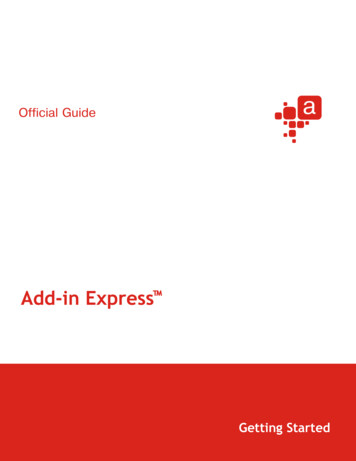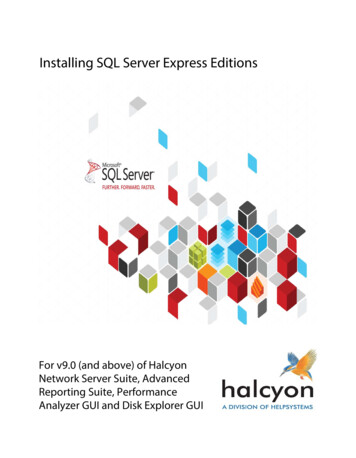
Transcription
The B2B marketplace has evolved and solutions have failed to keep pace withthis change. IBM can now demonstrate leadership in the community integrationspace with its new portfolio of WebSphere Business Integration offerings. Theseprovide connectivity between enterprises of varying sizes who want to ensurethey effectively integrate their trading relationships. Companies will derive bettervalue from their integrated value chain. They will shorten the end to end processof communicating with their partners and will be able to streamline the businessprocesses which rely on interactions with those partners. They will derive greaterinterpretability that realizes visible dynamic connectivity in a community oftrading partners. By improving levels of automation used in B2B exchanges andinteraction, community participants will gain substantial reductions in humanerror and costs.WBI Connect is available in three editions: Express: for small- and medium-business (SMB) and a number of quick startconnections in and between larger enterprises Advanced: for enterprises that have a well-defined size of community inwhich they participate and need a high degree of dynamism and fluidity withintheir community Enterprise: for enterprises that require unlimited scalability and highlyversatile trading partner connectionsThese three editions enable community integration through connectivity betweentrading partners, whatever the B2B requirement of the partner, and whatever thepreferred style of integration and connectivity. They all enable effectiveoperational B2B based on communities of trading partners and work with othercomponents of an end-to-end solution, typically provided by middle wareproducts; for example, WebSphere Business Integration Server, which providestransformation and process integration capabilities.Many interactions with trading partners are driven by the need to make internalbusiness processes more efficient. Extending internal business integration toinclude interactions with trading partners creates an end-to-end integratedsolution along the full length of your company’s value chain. Incorporating atrading partner interaction into an end-to-end integration solution necessitatesthe use of a B2B component within the internal implementation. This B2Bcomponent needs to extend the internal solution to provide the extra functionsand capabilities required when exchanging information with a trading partner inan integrated and legally editable way. Whatever the style of internal integrationused; the use of a B2B component, such as WebSphere Business IntegrationConnect working with internal applications, creates an end-to-end B2B solution.Community integration involves the selection of a multiplicity of transportmechanisms and the selection of the appropriate data format, whether it be aChapter 4. WebSphere: Enabling the solution integration123
generic data format such as XML or SOAP, or whether it be related to a particularindustry standard such as AS2 (an EDI standard for use over the Internet HTTPtransports) or Resultant (a standard common in the electronics industry using aspecific form of XML message as part of a defined business process). The abilityto select which of these you need to create a partner connection means you cancreate multiple distinct connections with a single trading partner. This means thatyou can conduct business with particular aspects of a trading partnerorganization and change the relationship as business conditions change.When looking to interact with another trading partner, you must agree on variousaspects of the level of integration. You must decide whether you want toexchange data to meet the B2B integration needs of your enterprise only, orwhether you want to extend your internal processes, and share them, as theinterface between the enterprises. You may also need to consider whether youneed to transform the data exchanged between you and your partners. Somecompanies will want the integration infrastructure to standardize all data to asingle format, with the data then being transformed as required. Others will justtransform data between applications as needed. The data standards used by atrading partner are likely to be different to the data formats and standards usedwithin your company. Even if a data format is agreed to, at least one party in theexchange is likely to need to transform the data.WBI Connect incorporates with other members of the business integration family,such as WebSphere Business Integration Message Broker and WebSphere DataInterchange, to perform data validation and transformation functions that enablevalidation that the data received by a partner is correct and well-formed. Anyinvalid data can be rejected by the product without further processing. Anyvalidated messages can then be sent on within the enterprise.WebSphere Business Integration Connect provides secure communication of thedata between trading partners. You can define partners and the requisitetransports, the security, encryption and auditing requirements in order toestablish distinct partner connections with a given trading partner. Additionally,the activities need to be monitored as part of a solution management functionwhile the partner definition function needs a management component in order toadd, delete and modify partner definitions.Community integration servicesIn order to deliver effective operational B2B, a significant amount of preparationand ennoblement support is required by the myriad community participants.Historically, B2B implementations have been costly and labor intensive, based asthey are on piecemeal partner identification and lengthy, unmarketable partnerennoblement processes. Instead of focusing on the connection of each individualpartner, Community Integration Services allows a framework to be implementedaround the awareness of the entire community of partners that are to be124BPM Meets BI
connected together. This ensures that more repeatable and rigorous processescan be applied to the individual connections as part of the overall project.Community Integration Services is a range of complementary services thatsupports the creation, growth and management of trading communities of anysize and type. These services are fully integrated with WebSphere BusinessIntegration Connect in order to provide all the support you need in establishingan operational B2B environment.Chapter 4. WebSphere: Enabling the solution integration125
126BPM Meets BI
5Chapter 5.DB2: Providing theinfrastructureIn this chapter we provide a high-level overview of the architecture of DB2Universal Database (DB2 UDB) and WebSphere (formerly DB2) InformationIntegrator. We also describe how these two products interact and complementeach other, and how you can use them to enable Business PerformanceManagement.DB2 represents the basic infrastructure, providing the robust data store requiredfor holding the organization’s information assets. DB2 delivers key capabilities:scalability for huge data volumes, high availability for supporting a worldwidemarketplace that demands access to data at any time, and performance tosatisfy the users’ needs. In this chapter we discuss key parameters andmonitoring facilities that are available in DB2 to manage application and systemperformance.Of course, having and storing data is one thing. Managing it to best serve users’needs is another. That is where data warehousing enters the picture. It providesthe base for organizing enterprise data to best serve the needs of all. Let’s take alook at how that is accomplished. Copyright IBM Corp. 2004. All rights reserved.127
5.1 Data warehousing: The baseIn this section, we focus on key components that are necessary when deployinga data warehouse. We discuss how DB2 handles the complexities of a datawarehouse, for example, growth, performance with mixed workloads, and thedemand for high availability.5.1.1 Scalability for growthA data warehouse typically starts out small, but then continues to grow over thelife of the data warehouse. The ability of the underlying database to adapt andscale with this continuous growth is essential.What do we mean when we say scalability? Here is a definition that should helpas we discuss the topic. It refers to: Scalability refers to how well a hardware or software system can adapt toincreased demands.In the case of a relational database, those increased demands are increases inthe number of users, or volume of data being managed.DB2 is ideally architects for any size data warehouse. For example, you may startwith a database server that has only one CPU and then scale out from therehorizontally, vertically, or both. DB2 utilizes a shared nothing architecture, whichmeans that each database partition is allocated specific and independentmemory and disk. This is true whether you choose a horizontal, vertical, or acombination of both approaches, for scalability.Horizontal scalabilityThe horizontal scalability approach involves connecting multiple physical serverstogether through a network, and then having the DB2 Data Partitioning Feature(DPF) utilize all the CPUs together.This approach lends itself to incredible scalability. For example, DB2 currentlysupports 1,024 nodes. And, each server can be a symmetric multiprocessor(SMP).Utilizing horizontal scaling requires the DB2 Data Partitioning Feature. The useof partitioning to scale is depicted in Figure 5-1.128BPM Meets BI
High-speed B2MemoryDB2MemoryMemoryDB2DB2TableFigure 5-1 Horizontal ScalabilityVertical scalabilityDB2 will automatically scale when you add CPUs. We suggest you also addmemory when you add CPUs, as depicted in Figure 5-2.For additional vertical scalability, you can use the DB2 Database PartitioningFeature to divide the server into logical DB2 Partitions. The communicationsbetween the partitions is facilitated by message processing programs within theSMP. This is a very efficient and effective form of communications because themessages are passed between the partitions via shared memory. Partitioningalso reduces the contention for resources because there is dedicated memoryallocated to each partition, and each partition assumes private ownership of itsdata. This results in improved efficiency when adding CPUs and better overallscalability within a single SMP machine.Chapter 5. DB2: Providing the infrastructure129
bleFigure 5-2 Vertical scalability5.1.2 Partitioning and parallelism for performanceAnother reason (other than for pure scalability) to consider partitioning yourdatabase is to improve performance. By adding DB2 partitions, the volume ofdata to be accessed by each partition is reduced, thus, enabling increasedperformance.You can also exploit DB2 parallelism capabilities to increase performance.There are several types of parallelism employed by DB2: I/O Parallelism: DB2 can open more than one I/O reader to access thedataset. This can be influenced by the configuration parameters(NUM IO SERVERS) and the environment variable (DB2 PARALLEL IO).DB2 can also be influenced to open more I/O readers by creating the tablespaces utilizing more than one container. Query Parallelism: There are two types of query parallelism that can be useddepending on the objective to be achieved.– Inter-Query: This type of parallelism is exploited when many applicationsare able to query the database concurrently, as depicted in Figure 5-3.130BPM Meets BI
Select . From .DataDatabase PartitionFigure 5-3 Inter-Query parallelism– Intra-Query: This type of parallelism refers to the ability of DB to segmentindividual queries into several parts and execute them concurrently.Intra-Query parallelism can be accomplished three ways, intra-partition,inter-partition, or a combination of both. Intra-Partition: Refers to segmenting the query into several smallerqueries within a database partition. This is depicted in Figure 5-4.Chapter 5. DB2: Providing the infrastructure131
Select . From nDatabasePartitionDatabasePartitionFigure 5-4 Intra-Query parallelism Inter-Partition: Refers to segmenting the query into several smallerqueries to be executed by several different database partitions. This isdepicted in Figure 5-5.Select . From .Select . From .DataDataDatabase PartitionDatabase PartitionFigure 5-5 Inter-Partition parallelism132BPM Meets BISelect . From .
Chapter 4. WebSphere: Enabling the solution integration 125 connected together. This ensures that more repeatable and rigorous processes can be applied to the individual connections as part of the overall project.










